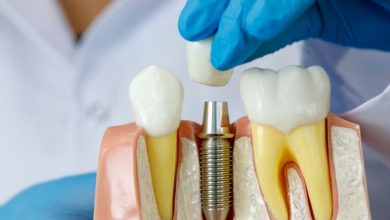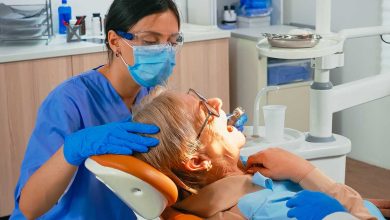Dental Emergencies Edmonton: Immediate Care For You

Dental emergencies can include:
- Bleeding.
- Loss of dental function.
- Difficulty opening or closing the mouth.
- Severe toothache.
- Swelling with fever and difficulty breathing.
- An avulsed or broken tooth.
Common dental emergencies may also include a toothache, chipped or broken teeth, a knocked-out tooth, a lost filling or crown, broken orthodontics, an abscess, or bleeding and pain after tooth extraction.
It is essential to seek immediate dental treatment for these emergencies to prevent further complications and alleviate pain.
Common Dental Emergencies And Their Symptoms
Are you experiencing a dental emergency in Edmonton? Look for symptoms like severe toothache, bleeding, difficulty opening or closing the mouth, swollen gums, or broken teeth. Seek immediate treatment to maintain your oral health.
It’s essential to know the common dental emergencies and their symptoms to take the necessary steps for immediate care.
This blog post will discuss toothaches, broken teeth, knocked-out teeth, abscessed teeth, and jaw fractures, including their causes, symptoms, and treatment options.
Toothache: Causes And Relief
- Tooth decay: Decay in the tooth can lead to a toothache.
- Gum infection: An infection in the gums can cause pain in the tooth.
- Tooth sensitivity: Tooth sensitivity to hot or cold foods can also result in a toothache.
- Tooth grinding: Regular grinding of the teeth can cause toothache and jaw pain.
- Dental abscess: A dental abscess can lead to severe toothache.
- Relief options: Applying a cold compress to the affected area can help reduce pain temporarily. Taking over-the-counter pain relievers like ibuprofen can also provide relief. However, it’s essential to visit a dentist to address the underlying cause of the toothache.
Broken Tooth: Types And Treatment
- Types: A broken tooth can range from a minor chip to a severe fracture.
- Cracked tooth: A crack in the tooth can range from a minor surface crack to a deep crack that extends toward the root.
- Fractured cusp: This is when a part of the tooth’s chewing surface breaks off.
- Split tooth: A split tooth is when a tooth is divided into two separate segments.
- Treatment: The treatment for a broken tooth depends on the severity of the damage. It can range from dental bonding or filling for minor chips to dental crowns or root canal treatment for more severe fractures. In some cases, extraction may be necessary.
Knocked-Out Tooth: How To Handle And Save The Tooth
- Handle with care: If a tooth is knocked out, handle it by the crown (the visible part) and avoid touching the root.
- Rinse gently: Rinse the tooth gently with water to remove dirt or debris.
- Reinsert if possible: Try to reinsert the tooth back into its socket. Make sure it’s facing the right way.
- Store properly: If reinsertion isn’t possible, store the tooth in a milk container or a tooth preservation solution.
- Seek immediate dental care: See a dentist immediately after a tooth is knocked out for the best chance of successful reattachment.
Abscessed Tooth: Signs, Symptoms, And Treatment
- Signs and symptoms: Severe toothache, swelling of the face or gums, a fever, and a bad taste in the mouth are frequently associated with an abscessed tooth.
- Causes: Severe tooth decay or a dental infection are typically the causes of an abscessed tooth.
- Treatment: Treatment for an abscessed tooth involves draining the abscess and treating the underlying infection. This may include root canal therapy, antibiotics, or tooth extraction.
Jaw Fracture: Signs And Emergency Response
- Signs: Signs of a jaw fracture include severe pain, difficulty opening or closing the mouth, misaligned teeth, and swelling of the face.
- Emergency response: If you suspect a jaw fracture, seeking immediate medical attention is vital. Apply a cold compress to reduce swelling, and avoid eating or moving the jaw until medical help is available.
Knowing the common dental emergencies and their symptoms can help you take quick action to alleviate pain and protect your oral health. However, it’s important to remember that these are general guidelines, and it’s always best to consult a dental professional for an accurate diagnosis and appropriate treatment.
Don’t hesitate to contact your dentist in Edmonton in case of a dental emergency.
Steps To Take In A Dental Emergency
In a dental emergency, it’s essential to take immediate action. Whether it’s a severe toothache, a broken tooth, or swelling, seek professional dental care at Dental Emergencies Edmonton to address your oral health needs.
Stay Calm And Assess The Situation
When faced with a dental emergency, staying calm and assessing the situation is essential. Panicking can only worsen the situation, so take a deep breath and evaluate the severity of the issue. Here are some steps to consider:
- Examine the affected area: Look for visible signs of damage or injury, such as bleeding, swelling, or loose teeth.
- Assess the pain level: Take note of the intensity and duration of the pain. This information will help your emergency dentist determine the best course of action.
- Determine the cause: Try to identify what caused the dental emergency. Was it a sports injury, a fall, or sudden pain?
Remember, staying calm and assessing the situation will enable you to make informed decisions on the following steps.
Contact An Emergency Dentist
Once you have assessed the situation, it is crucial to contact an emergency dentist immediately. Dental emergencies should not be ignored or delayed, as prompt treatment can prevent further damage and alleviate pain. Here’s what you should do:
- Call your regular dentist: If it’s during their office hours, contact your regular dentist first. They can accommodate you and provide the necessary emergency dental care.
- Search for emergency dental services: If it’s outside your dentist’s office hours or unavailable, search for emergency dental services in your area. Look for dentists who specialize in handling dental emergencies or have extended hours for emergencies.
- Explain the situation: Explain the dental emergency clearly and concisely when speaking with the dentist or their staff. This will help them understand the urgency and prioritize your case.
Prompt action is vital in a dental emergency, so don’t hesitate to contact an emergency dentist for immediate assistance.
Manage Pain And Discomfort At Home
While waiting for your emergency dental appointment, there are steps you can take to manage pain and discomfort at home. Here’s what you can do:
- Over-the-counter pain relievers: Take over-the-counter pain medication to alleviate pain, such as ibuprofen or acetaminophen. Follow the instructions on the packaging and consult a healthcare professional if needed.
- Rinse with warm salt water: Rinse your mouth with warm water and salt. This can help reduce swelling and ease any discomfort.
- Apply a cold compress: If swelling occurs, apply a cold compress or ice pack to the affected area for 10–15 minutes. This can help reduce swelling and alleviate pain.
Remember, these home remedies are temporary and should not replace professional dental care. They are meant to provide relief until you can see an emergency dentist.
Preserve A Knocked-Out Tooth
In some dental emergencies, a tooth may get knocked out. Preserving the tooth properly is crucial to increasing the chances of successful reimplantation. Follow these steps:
- Handle the tooth carefully: Pick up the tooth by the crown (the top part) and avoid touching the root.
- Rinse gently: If the tooth is dirty, gently rinse it with water. Do not use soap or any cleaning agents.
- Place it back in the socket: If you can, try to place the tooth back into it. Gently bite on a clean cloth or gauze to hold it in place.
- Preserve it in milk or saliva: If you can’t reinsert the tooth, place it in a container with milk or your saliva to keep it moist. This will help preserve the tooth until you can see the emergency dentist.
Remember, time is critical when dealing with a knocked-out tooth, so seek immediate dental care to maximize the chances of saving the tooth.
Prevent Further Damage Before Receiving Treatment
While waiting to see the emergency dentist, take precautions to prevent further damage to your teeth or mouth. Here’s what you can do:
- Avoid chewing on the affected side: If a tooth is loose or injured, avoid putting pressure on it by chewing on the opposite side of your mouth.
- Use temporary dental cement: If a dental filling or crown falls out, you can use temporary dental cement available at most pharmacies to cover the exposed area. This will protect it until you can see the emergency dentist.
- Avoid extreme temperatures: Sip on lukewarm or cold beverages to avoid aggravating dental sensitivity or pain.
- Be cautious with oral hygiene: Brush and floss gently around the affected area, taking care not to cause further injury or discomfort.
Remember, these preventive measures are temporary and should not replace professional dental care. Seeking prompt treatment from an emergency dentist is essential for proper diagnosis and treatment.
Finding The Right Emergency Dentist In Edmonton
Are you looking for an emergency dentist in Edmonton? Don’t worry. We’ve got you covered. Our experienced and highly trained dentists are here to provide comprehensive services for all your dental emergencies. Your oral health is our top priority, so contact us today for prompt and friendly care. Also, you should do the following:
Research Local Emergency Dental Clinics
When faced with a dental emergency in Edmonton, finding a reliable emergency dentist who can provide immediate care is essential. Here are some steps to help you research local emergency dental clinics:
- Look for online directories or search engines that list emergency dental clinics in Edmonton.
- Check the websites of dental clinics to gather more information about their services and expertise.
- Consider asking for recommendations from friends, family, or your regular dentist.
- Contact local dental associations or organizations for a list of emergency dentists in your area.
- Take note of the clinic’s location, contact details, and working hours for easy reference.
Check out Reviews and Ratings.
Before deciding on an emergency dentist, assessing their reputation and track record is essential. Here’s how you can check reviews and ratings:
- Read online reviews on platforms like Google, Yelp, or Healthgrades to get insights from previous patients.
- Look out for positive reviews that highlight a dentist’s professionalism, expertise, and quality of care.
- Respond to negative feedback about long wait times, unavailability, or poor customer service.
Evaluate the Dentist’s Experience And Specializations
When it comes to emergency dental care, experience and specialized knowledge play crucial roles. Consider the following factors:
- Determine how long the dentist has been practicing emergency dentistry.
- Check if they have any specific training or certifications in emergency dental procedures.
- Evaluate their expertise in handling common dental emergencies such as tooth fractures, abscesses, or knocked-out teeth.
Consider Accessibility And Availability
An emergency dentist should be easily accessible and available when you need them the most. Keep the following points in mind:
- Check the clinic’s proximity to your location to ensure quick emergency access.
- Inquire about their availability after regular office hours, on weekends, or holidays.
- Find out if the dentist offers 24/7 emergency services or has an emergency hotline for immediate assistance.
By conducting thorough research, checking reviews, evaluating experience, and considering accessibility and availability, you can find the right emergency dentist in Edmonton who can provide prompt and reliable care during dental emergencies. Remember to save their contact information for easy access in an emergency.
Frequently Asked Questions On Dental Emergencies Edmonton
What Can Be A Dental Emergency?
Dental emergencies can include:
- Bleeding.
- Loss of dental function.
- Difficulty opening or closing the mouth.
- Severe toothache.
- Swelling with fever and breathing.
- Avulsed or broken teeth.
What Is The Most Common Dental Emergency?
The most common dental emergencies are a toothache, chipped or broken teeth, and a knocked-out tooth.
What Is A Dental Emergency, And How Do You Deal With One?
A dental emergency includes severe toothache, bleeding, broken or avulsed teeth, difficulty breathing, and fever-causing swelling. Seek immediate professional dental help.
How Much Does It Cost To Remove Wisdom Teeth In Quebec?
The cost of removing wisdom teeth in Quebec varies.
Conclusion
Dental emergencies can happen to anyone at any time, causing pain and discomfort. When faced with a dental emergency in Edmonton, it is crucial to seek immediate professional help. Prompt dental care is essential to prevent further complications, whether you are experiencing a severe toothache, a broken tooth, or swelling that affects your breathing.
Finding an experienced and highly trained dentist in Edmonton is vital to addressing dental emergencies effectively. They can provide the necessary treatment to alleviate pain, repair damaged teeth, and restore oral health. With their comprehensive services and friendly staff, you can rely on their expertise and support during challenging dental situations.
Remember that dental emergencies should never be ignored or delayed. Seeking prompt attention and proper treatment can make a significant difference in preserving your oral health and preventing further damage. Whether you need emergency dental care, have a lost filling or crown, or require assistance with broken orthodontics, Edmonton’s dental professionals can provide the care you need.
Prioritize your dental health and seek help immediately to ensure a speedy and successful recovery.






2 Comments